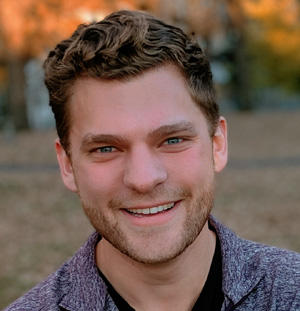
Roman Tyshynsky
Thesis Title:
An Anatomical and Optogenetic Investigation of Periglomerular Sensory Fibers in the Mouse Kidney.
Current Position:
Scientific and Communications Liaison
Minnesota Consortium for Autonomic Neuromodulation
Undergraduate Institution and Major:
St. Olaf College Biology/Neuroscience Concentration 2016
Graduate Advisor:
Lucy Vulchanova, Ph.D., Department of Neuroscience
John Osborn, Jr., Ph.D., Department of Integrative Biology and Physiology
Description of Graduate Research:
I am mapping the anatomy and function of renal nerves, specifically focusing on the role of sensory nerve fibers within the cortex of the kidney. The nonspecific ablation of renal nerves is currently being explored as a treatment for patients with treatment-resistant hypertension. While the results are promising, our understanding of the specific roles of renal nerves is currently lacking. My research aims to bridge this gap and may lead to more effective and specific renal nerve-based treatments.
Graduate Publications:
- Periglomerular afferent innervation of the mouse renal cortex. Front Neurosci. 2023 Jan 26;17:974197.
- Osborn JW, Tyshynsky R, Vulchanova L. Function of renal nerves in kidney physiology and pathophysiology. Annu Rev Physiol. 2021;83:429-450.Brown JL, Lyons CE, Toddes C, Monko T, Tyshynsky R. Reevaluating tear gas toxicity and safety. Inhal Toxicol. 2021 Sep 12:1-16.
- Brown JL, Lyons CE, Toddes C, Monko T, Tyshynsky R. Tear gas safety and usage practices. Journal of Science Policy and Goverance. 2021;18(1):https://doi.org/10.38126/JSPG180104.
- Legon W, Bansal P, Tyshynsky R, Ai L, Mueller JK. Transcranial focused ultrasound neuromodulation of the human primary motor cortex. Sci Rep. 2018 Jul 3;8(1):10007.
Graduate Level Abstracts:
- Tyshynsky R, Asirvatham-Jeyaraj N, Larson E, Skorput A, Sanders M, Gore R, Riedl M, Van Helden D, Banek C, Thomas, Vulchanova L, Osborn J. Structural and functional neurobiology of renal nerves: A platform for neuromodulation of renal function. Poster at Annual NIH SPARC Initiative Meeting, Bethesda, MD. 2018
- Tyshynsky R, Banek C, Skorput A, Larson E, Gore R, Riedl M, Osborn J, Vulchanova L.,Mapping the neuroanatomy and function of renal nerves. Poster at 2018 Neuromodulation Symposium, University of Minnesota, Minneapolis, MN. 2018
- Tyshynsky R, Banek C, Skorput A, Larson E, Gore R, Riedl M, Osborn J, Vulchanova L.,Mapping the neuroanatomy and function of renal nerves. Poster at 2018 Wallin Neuroscience Discovery Day, University of Minnesota, Minneapolis, MN. 2018
- Tyshynsky R, Banek C, Skorput A, Larson E, Gore R, Asirvatham-Jeyaraj N, Riedl M, Osborn J, Vulchanova L. Clarifying the neuroanatomy and function of renal nerves in hypertension. Poster at 2018 Graduate Program in Neurosciences Retreat, University of Minnesota, Minneapolis, MN. 2018
Graduate Awards/Honors:
- Ruth Kirschstein Individual National Research Service Award F31 2020-2022
- MnDRIVE Fellowship in Neuromodulation, 2018-2019
Graduate Program in Neuroscience Committees:
- Admissions Committee 2018-2020
- Student Board 2017-2019
Thesis Committee Members:
- Alessandro Bartolomucci, Ph.D., Department of Integrative Biology and Physiology (Chair)
- Lucy Vulchanova, Ph.D., Department of Neuroscience
- Eric Newman, Ph.D., Department of Neuroscience
- John Osborn, Jr., Ph.D., Department of Integrative Biology and Physiology
- Esther Krook-Magnuson, Ph.D., Department of Neuroscience
Undergraduate Awards:
- Buntrock Scholar (2012-2016)
Undergraduate or Post-Bac Research:
I worked on the design and helped build an apparatus with which to study sound localization in humans.
What Got You Interested In Research?
Rotations:
- Silvia Mangia, Ph.D., Department or Radiology
- Tay Netoff, Ph.D., Department of Biomedical Engineering
- Paul A. Iaizzo, Ph.D., Department of Surgery, Integrative Biology and Physiology
- Lucy Vulchanova, Ph.D., Department of Neuroscience
- John W. Osborn, Jr., Ph.D. Department of Integrative Biology and Physiology
- Timothy J. Ebner, MD, Ph.D., Department of Neuroscience
Why Did You Choose MN?
Our program heavily emphasizes collaboration across many departments and disciplines. Not only do we have some of the brightest minds in the field, but they value new ideas and appreciate graduate students’ abilities to solidify strong connections between labs. Itasca provided a unique opportunity to bond with my cohort members and to create a stable support system before we tackled the next 4-6 years of our lives.
Student Mentor and the Best Advice They Gave:
Zach Zeidler: The lab members in your rotations are some of your most useful resources when trying to make a decision about which lab to join – get to know them well.
